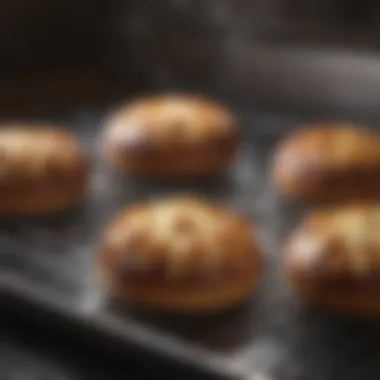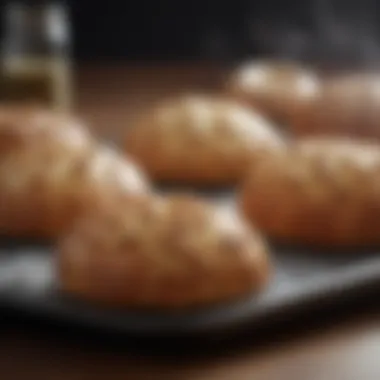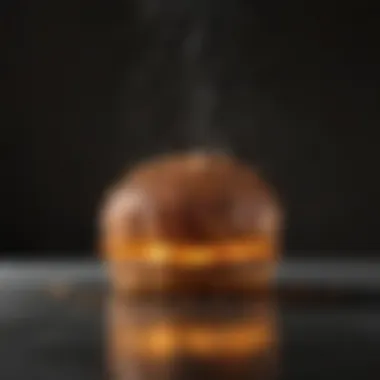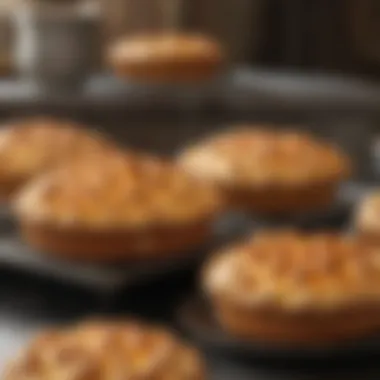Convection Baking vs Traditional Baking: A Comprehensive Analysis


Intro
In the realm of baking, the method you choose can profoundly affect the outcome of your recipe. Convection baking and traditional baking each have unique characteristics that cater to different needs in the kitchen. As culinary enthusiasts or busy home cooks look for efficient and effective methods, understanding these distinctions becomes essential. This article explores the intricacies of both techniques, addressing the mechanisms, benefits, and practical applications of convection and traditional baking. By delving into these methods, we aim to empower cooks with the knowledge needed to elevate their culinary creations.
Recipe Overview
Fluffy Chocolate Chip Cookies
- Number of portions: 24 cookies
- Time required for prep and cook: 30 minutes prep, 12 minutes bake
- Difficulty: Easy
- Main ingredients:
- All-purpose flour
- Butter
- Sugar
- Brown sugar
- Egg
- Chocolate chips
These cookies serve as an excellent example to illustrate the differences in technique. Using both convection and traditional baking, you can see how heat distribution impacts the final texture and flavor.
Step-by-Step Instructions
Preparation:
- Gather your ingredients: Ensure all items are at room temperature for best results.
- Preheat your oven: Convection settings typically require a lower temperature by about 25 degrees Fahrenheit compared to traditional baking (e.g., 325°F for convection, 350°F for traditional).
- Mix dry ingredients: In a bowl, combine flour, baking soda, and salt.
- Cream butter and sugars: In a separate mixing bowl, beat butter, granulated sugar, and brown sugar until fluffy.
- Add eggs and vanilla: Mix in one egg at a time, along with the vanilla extract.
- Combine mixtures: Gradually add the dry mixture to the wet ingredients, mixing until just combined.
- Fold in chocolate chips: Add in the chocolate chips gently.
Baking:
For Convection Baking:
- Drop spoonfuls of cookie dough on a parchment-lined tray.
- Bake for about 10-12 minutes.
- The convection fan will circulate air, yielding a slightly crisp exterior.
For Traditional Baking:
- Follow the same procedure for placing dough on the tray.
- Bake for about 12-14 minutes.
- The result will be a softer cookie with a chewy center.
Time-saving strategies: To speed up the process, consider using pre-measured ingredients or pre-made dough available at the store.
Nutritional Information
Per Cookie:
- Calories: 150
- Proteins: 2g
- Fats: 8g
- Carbohydrates: 20g
- Beneficial nutrients: Offers small amounts of calcium from chocolate, essential for bone health.
Quick Cooking Tips
- Use a stand mixer for quicker and more efficient mixing of ingredients.
- Multitask by prepping other snacks or meals while your cookies bake.
- For a healthier option, consider using whole wheat flour or a sugar substitute like Stevia.
Related Recipes & Variations
- Peanut Butter Cookies: Use peanut butter in place of some butter for a different flavor.
- Gluten-Free Cookies: Substitute all-purpose flour with gluten-free alternatives such as almond flour.
- Share your takes: Join discussions on sites like Reddit about baking techniques and share your variations.
Understanding Baking Techniques
Baking is a fundamental cooking technique that transforms raw ingredients into varied and complex foods. Understanding different baking techniques is essential for culinary enthusiasts aiming to expand their skills and improve their outcomes in the kitchen. This article compares convection baking and traditional baking, highlighting their distinct mechanisms, benefits, and applications. By mastering these techniques, home cooks can enhance efficiency, maintain quality, and cater their baking methods to specific recipes.


Definition of Baking
Baking is the process of cooking food by surrounding it with dry heat. This method usually occurs in an oven. The science of baking involves chemical reactions where ingredients undergo transformation, resulting in textures and flavors that are unique to baked goods. While it may seem straightforward, the intricacies of baking require careful attention to details such as temperature, timing, and ingredient interactions.
Overview of Convection Baking
Convection baking utilizes the principles of forced air circulation to evenly distribute heat. Unlike traditional ovens, convection ovens have built-in fans that promote airflow. This feature enables quicker cooking times and a more uniform heat exposure. When using convection, moisture can evaporate rapidly, which often results in a crisp crust. The efficiency afforded by convection baking makes it an attractive option for busy cooks. Many professional chefs favor convection settings for roasting meats and baking pastries due to consistent and desirable results.
Overview of Traditional Baking
Traditional baking relies primarily on radiant heat from the oven's walls and the baking surface. The heat cooks food from the outside in, which can lead to uneven baking if one is not attentive. Traditional baking is often seen as the classic method, used widely for a variety of dishes. Many nostalgic recipes utilize this method, bringing warmth and familiarity to family gatherings. Though traditional ovens may take longer and may require more precise timing, the outcomes can be quite flavorful and comforting. Understanding this method is vital for home bakers who prefer time-tested recipes.
Mechanisms of Heat Transfer
Understanding the mechanisms of heat transfer is crucial when comparing convection baking and traditional baking. Each method utilizes different principles to communicate heat, which directly affects not just cooking time but also texture and flavor. Convection baking employs the movement of air to enhance heat transfer, while traditional baking relies on conduction and radiation. This section explores these fundamental processes and reveals their significance in culinary outcomes.
Convection: How It Works
Convection baking is defined by the circulation of heated air within the oven. When the oven heats up, a fan usually ensures that warm air is distributed evenly. This uniform airflow promotes more consistent cooking and baking compared to still air in traditional methods. As heat is distributed evenly, food can cook faster and often at lower temperatures.
Using convection, one might observe that cookies brown more evenly, and roasts develop a crispy crust while retaining moisture inside. The interactions between the air currents and the food surface help to eliminate cool spots, which can cause uneven cooking. This mechanism is beneficial for achieving a desirable texture, especially for baked goods like pastries and bread.
Traditional Baking: Conduction and Radiation
Traditional baking relies on conduction and radiation for heat transfer. In this method, heat travels directly from the oven walls and heating elements to the food. Conduction occurs through solid materials; thus, metal baking trays or stone surfaces are typically preferred. These materials absorb heat and transfer it to the food in contact.
Radiation, on the other hand, involves the transfer of heat through infrared waves. The oven’s heating elements emit radiant heat that cooks food from the outside in. While traditional ovens can provide good results, they often leave hot spots, which may lead to uneven baking. For instance, items near the oven surface can brown faster than those located towards the center, impacting texture and flavor.
Both mechanisms ultimately contribute to the overall cooking experience. Understanding how convection and traditional baking function will allow cooks to make informed decisions that enhance their culinary outcomes. Consequently, incorporating the right techniques into one’s cooking arsenal can lead to notable improvements in the kitchen.
Effects on Cooking Time
Understanding the effects on cooking time is crucial when evaluating the differences between convection baking and traditional baking. Cooking time can significantly impact the efficiency of meal preparation. For individuals with busy lifestyles, knowing which method optimizes time without sacrificing quality is essential. This section will provide a detailed exploration of how each baking technique influences cooking times—offering insights that can aid culinary enthusiasts in their cooking endeavors.
Cooking Time in Convection Baking
Convection baking is known for its ability to cook food faster than traditional methods. This is primarily due to the convection fan that circulates hot air within the oven. As the hot air moves around the food, it removes cooler air surrounding it, allowing for more even and efficient heat transfer.
Typically, convection baking can reduce cooking times by approximately 25%. This reduction varies depending on several factors, including the recipe, food size, and the specific oven used. Foods such as pastries or delicate items can particularly benefit as they bake evenly without burning or becoming soggy. Adjusting the temperature and timing can enhance these advantages, ensuring meals are ready quickly and efficiently.
Cooking Time in Traditional Baking
Traditional baking, conversely, often entails longer cooking times due to its reliance on static heat sources. In this method, heat transfers mostly through conduction and radiation. The oven walls and internal heating elements warm up, gradually heating the air around the food. This process is noticeably slower than convection baking.
Usually, traditional baking demands more attention to timing. Understanding the precise duration for various recipes is essential to avoid undercooking or overcooking, which can affect flavor and texture. Foods like bread and casseroles are typically baked longer in conventional ovens, often requiring specific methods to achieve the desired results without compromising quality.
Comparative Analysis of Cooking Times
When we compare convection and traditional baking, the differences become evident. Here are some key points to consider:


- Speed: Convection baking significantly decreases cooking times, making it advantageous for quick meals.
- Temperature: Most recipes can be adjusted by reducing the temperature by 25 degrees Fahrenheit when using convection, leading to more effective time management.
- Food Type: Cooking times also depend on the food type. For instance, larger cuts of meat may not see as much time difference, while baked goods like cookies can be faster in convection ovens.
"Understanding how cooking methods affect time can transform culinary practices, catering to both busy schedules and quality standards."
Ultimately, choosing between convection and traditional baking involves evaluating how time affects your cooking processes. Each method has its strengths and may suit various recipes and lifestyles differently. Understanding these nuances will guide better decision-making in the kitchen.
Heat Distribution and Its Impact
The topic of heat distribution plays a crucial role in both convection and traditional baking. Understanding the mechanisms behind how heat is distributed can significantly impact the quality of the final baked product. The uniformity or lack thereof in heat distribution can lead to variations in texture, color, and overall cooking performance. This discussion will delve into the differences in heat distribution between convection and traditional ovens, highlighting the benefits and considerations crucial for culinary enthusiasts.
Uniformity in Convection Baking
Convection baking utilizes a fan and an exhaust system to circulate hot air throughout the oven. This method enables more even heat distribution compared to traditional baking. The consistent airflow prevents any cold spots in the oven, ensuring that all parts of the dish are cooked uniformly. The result is often a more desirable texture, with even browning and reduced chances of overcooking or burning.
Some additional features of convection processes include:
- Faster Cooking: The efficient circulation of hot air often results in reduced cooking times.
- Multiple Rack Use: The uniform heat allows for cooking multiple dishes on different racks simultaneously without compromising quality.
- Enhanced Crispness: Foods, especially those that benefit from a crispy exterior, achieve better results in a convection oven.
Understanding these benefits allows cooks to appreciate the advantages of convection baking, particularly when it comes to recipes that require precision and quality.
Heat Hotspots in Traditional Baking
In traditional baking, heat is mainly transferred through conduction and radiation, which can often lead to uneven cooking. Traditional ovens can have hot spots, areas where the temperature is significantly higher than in others. This irregular heat distribution can affect the outcome of baked goods. For instance, items placed in hotter zones may bake faster, risking burnt edges or an unevenly cooked center.
Here are some common issues related to heat distribution in traditional baking:
- Baking Unevenness: Cakes may rise unevenly or bread may develop an unappealing texture.
- Temperature Fluctuations: Opening the oven door allows heat to escape, further complicating the even spread of heat.
- Inefficient Multiple Baking: Baking multiple items can become problematic, as different products may require different baking times or temperatures.
Recognizing these issues encourages bakers to monitor their dishes closely, often turning pans or rotating trays to combat the uneven cooking presented by traditional ovens. Understanding both baking methods can aid cooks in making informed decisions about which technique best suits their desired outcomes.
Texture and Flavor Outcomes
When it comes to baking, texture and flavor largely determine the quality of the final product. Texture influences how a dish is perceived, affecting everything from mouthfeel to visual appeal. Flavor, on the other hand, plays a critical role in the overall enjoyment of a dish. The baking method utilized can significantly alter both these aspects. This section will compare how convection baking and traditional baking operate in terms of texture and flavor outcomes, providing a clear perspective for culinary enthusiasts.
Crispiness and Browning in Convection Baking
Convection baking often leads to superior crispiness and enhanced browning of foods. This occurs due to the circulation of hot air inside the oven. In convection ovens, a fan continuously moves air around, ensuring that the surface of the food is evenly heated. This mechanism promotes Maillard reactions, which contribute to browning. As a result, dishes like roasted vegetables, pastries, and meats exhibit a beautifully crispy exterior. The rapid air movement also reduces moisture content on the surface, aiding in achieving that crisp texture.
For instance, when baking chicken, convection allows the skin to become golden brown and crunchy because hot air circulates around the chicken, eliminating moisture while sealing in juiciness. This contrasts with traditional baking, where heat can be unevenly distributed, leading to a less crispy and less attractive outer layer.
The benefits of convection baking are clear in recipes where crispiness is essential. For example, bread baked in a convection oven can have a delightful crust while maintaining soft, airy insides. Tailoring recipes specifically for convection systems can enhance textural qualities beyond those achieved with conventional methods.
Moisture Retention in Traditional Baking
Despite the advantages of convection baking, traditional baking has its own strengths, particularly in moisture retention. Traditional ovens primarily utilize conduction and radiation to transfer heat. This method allows foods to retain moisture better, which can be important for certain baked goods.
For instance, cakes and custard dishes benefit from the gentle, even heating that traditional ovens provide. The moist environment helps prevent excessive drying out, resulting in tender, flavorful outcomes. When baking a chocolate cake, a traditional oven can keep the interior moist, yielding a rich texture that many prefer.
Moreover, specific dishes like casseroles or soufflés find success using traditional baking, as these require a specific amount of moisture to properly set. The slower cooking times and the lack of air movement in traditional baking mean that the dish cooks at a more controlled rate, allowing for better moisture retention.


Energy Efficiency Considerations
Energy efficiency is an important aspect of modern cooking techniques. In culinary practices, understanding how various baking methods impact energy consumption can lead to environmentally friendly and cost-effective decisions. Most people are more aware of energy bills these days, making it vital to evaluate how convection and traditional baking compare in terms of their energy usage. Choosing the right baking method could not only save money but also minimize one's carbon footprint, which has increasingly gained attention.
One of the benefits of convection baking is its effectiveness in using energy due to its design. Convection ovens operate by circulating hot air around food, allowing for even cooking at lower temperatures. This means that convection ovens often achieve the same results as traditional ovens while consuming less energy. Additionally, since food generally cooks faster in convection ovens, users can cut down on the total cooking time, further reducing electricity usage.
Energy Consumption of Convection Ovens
Convection ovens utilize a fan and exhaust system that creates a flow of air around the food. This air circulation is key to the oven's efficient performance. As it cooks faster and more evenly, it allows the chef to set the temperature lower than what would be needed in a traditional oven.
- Reduced Cooking Time: Cook times can be reduced by about 25%. This means less time spent using the oven, leading to lower energy costs over time.
- Lower Temperatures: You might find it effective to bake at 25°F (about 14°C) less than the traditional method. Lower temperatures coupled with quicker cooking times contribute to overall energy savings.
- Faster Preheating: Convection ovens usually preheat faster than traditional ovens, which can also save energy.
The design and operation of convection ovens prioritize efficiency, making them a practical choice for those concerned about energy use in their everyday cooking.
Traditional Ovens and Energy Use
Traditional ovens rely primarily on radiation heat transfer and conduction to cook food. These methods tend to result in uneven heating and, often, hotspots within the oven. The following points highlight how traditional ovens compare in terms of energy usage:
- Longer Cooking Times: The longer cooking times typical of traditional baking lead to higher energy consumption. This can add to monthly electricity bills.
- Higher Temperature Settings: Traditional ovens often require higher temperatures to achieve desired results, which increases energy usage substantially during preheating and cooking.
- Inefficiency in Heat Distribution: Hotspots may cause some areas to cook faster than others, leading cooks to run the oven longer to ensure even cooking.
Overall, while traditional ovens have their merits, such as their availability and familiar user interfaces, they tend to be less energy-efficient than convection ovens. The choice between these two methods should reflect both culinary goals and sustainability considerations.
"Energy efficiency in baking is not just about saving money; it equally benefits the environment. Choosing the right method matters."
By understanding the energy dynamics of convection versus traditional baking, culinary enthusiasts can improve their cooking techniques while also contributing positively to both their finances and the planet.
Practical Applications in Cooking
Understanding practical applications of both convection and traditional baking is crucial for home cooks who seek efficiency without sacrificing quality. The way heat circulates in each method influences everything from flavor to texture. Thus, knowing when to utilize each technique can greatly enhance cooking outcomes.
Best Recipes for Convection Baking
Convection baking is exceptional for achieving a uniform finish and crispiness in various dishes. Here are several types of recipes that benefit enormously from this technique:
- Roasted Vegetables: The hot air circulation caramelizes the sugars in the vegetables, producing rich flavors and vibrant colors.
- Crispy Skins: Whether it's chicken or fish, convection baking helps achieve that delightful crisp texture on the exterior.
- Cookies and Pastries: The even temperature ensures that cookies bake homogeneously, producing golden edges and chewy centers.
- Pizzas: With high temperatures and consistent heat distribution, convection ovens create perfect pizza crusts that are both crispy and chewy.
When adapting traditional recipes, decrease the temperature by about 25°F for convection baking. This adjustment compensates for the more efficient heat distribution.
Suitable Dishes for Traditional Baking
Traditional baking has its own merits and is ideal for specific dishes. The slower cooking process allows for the retention of moisture in recipes that require it. Consider these options:
- Breads and Loaves: The slow baking can improve texture, yielding soft interiors and perfectly crusty exteriors.
- Cakes: Traditional baking works well for delicate cakes, allowing them to rise evenly without drying out.
- Custards and Puddings: Low and slow is the key here; traditional methods prevent burning while setting the perfect consistency.
- Casseroles: Even though these dishes can be done in convection, traditional ovens emphasize the mixing of flavors as they slowly meld together over time.
Final Thoughts on Choosing a Baking Method
When deciding between convection baking and traditional baking, one must consider several factors that can significantly affect the outcome of culinary endeavors. Each method presents unique advantages and disadvantages, making the choice context-dependent. The goal is to align the baking technique with specific culinary requirements, personal preferences, and available equipment.
Factors to Consider
- Type of Dish: Certain dishes benefit from the uniform heat distribution of convection baking, ensuring even cooking and browning. For instance, baked goods like cookies and pastries can achieve a desirable crispness. Traditional baking may yield better results for more delicate items, such as soufflés, where a gentle heat is preferable.
- Baking Time: Convection ovens can cook food faster due to their efficient heat circulation. Therefore, recipes may need minor adjustments in cooking time. Being aware of these time variations is crucial to avoid overcooking or undercooking. Cooking times can vary widely between the two methods, especially for larger items like roasts.
- Energy Consumption: Convection ovens typically use less energy due to shorter cooking times. This can be an essential consideration for those keen on energy efficiency and sustainability in their cooking practices.
- Equipment Availability: The choice of method may simply depend on the type of oven available. For individuals with only traditional ovens, mastering traditional techniques may be necessary. On the other hand, those with access to high-quality convection ovens can explore a range of new recipes and techniques.
Personal Preferences and Lifestyle
Culinary preferences and lifestyles also dictate the ideal baking method. Those with limited time may lean towards convection baking for its speed, while home chefs who relish the traditional approach will find value in the nuances of classical recipes.
- Skill Level: Beginners may find traditional baking more straightforward. Convection baking requires an understanding of how to adjust recipes and cooking times effectively. Therefore, individuals should assess their comfort level with each method before diving in.
- Taste Preferences: Texture and flavor outcomes differ between the two methods. For instance, individuals who prefer crusty, golden-brown exteriors might favor convection baking, while those who prioritize moist interiors may choose traditional baking techniques. As tastes vary, so too should the chosen baking method.
- Health Considerations: Baking styles can affect the nutritional composition of food. For instance, convection baking allows for faster cooking, which can help retain more nutrients compared to prolonged heat exposure in traditional baking.







